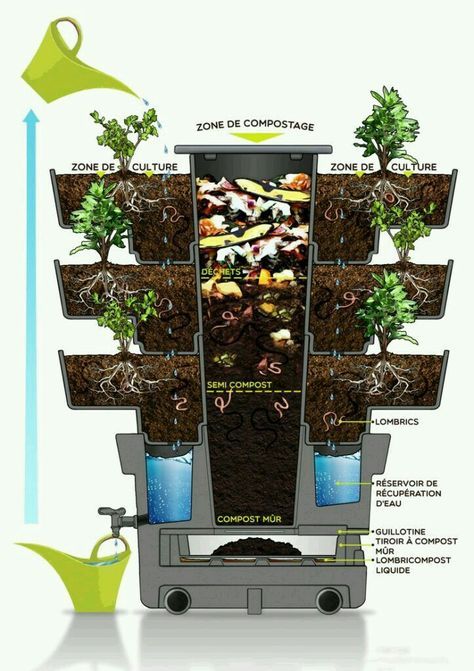“A smart design where kitchen scraps become fertile soil, worms do the hard work, and plants thrive in a self-sustaining cycle of compost, water, and life.”
🛠️ How It Works (Step by Step)
1. Composting Zone (Top Section)
- Food waste, vegetable peels, and organic scraps are dropped into the composting chamber.
- This is the “Zone de Compostage”, where natural decomposition begins.
2. Decomposition Process
- The waste breaks down into semi-compost with the help of worms (lombrics).
- Worms digest the organic matter and turn it into nutrient-rich vermicompost.
3. Planting Zones (Side Pockets)
- On each side, there are “Zones de Culture” (cultivation zones).
- Plants grow in these pockets, and their roots stretch toward the compost chamber, drawing nutrients directly from the decomposing waste.
- Worm tunnels naturally aerate the soil and keep it fertile.
4. Mature Compost Collection (Bottom Section)
- Over time, the compost becomes “compost mûr” (mature compost) at the bottom.
- There is a drawer (tiroir à compost) to easily collect the finished compost for reuse in gardens or pots.
5. Water Recycling
- At the bottom, a water recovery tank (réservoir de récupération d’eau) collects excess liquid, also known as “worm tea” (lombricompost liquide).
- This liquid is an excellent natural fertilizer that can be tapped using the spout and reused for watering plants.
6. Sustainability Features
- Zero waste: Kitchen scraps are recycled into food for plants.
- Water-efficient: Collects and reuses water instead of letting it run off.
- Space-saving: Vertical design makes it ideal for urban balconies, rooftops, and small homes.
🌿 Benefits
- Reduces Household Waste → Less garbage going to landfills.
- Fertile Soil Production → Creates rich compost naturally.
- Fresh Organic Food → Perfect for growing herbs, vegetables, and leafy greens.
- Compact Design → Saves space while producing food and compost.
- Natural Cycle → Worms, plants, water, and humans all benefit in a closed-loop system.
✅ In short: This system is like having a mini ecosystem in a box — waste goes in, worms do the work, plants thrive, and water is recycled. It’s a perfect solution for eco-friendly urban living.
